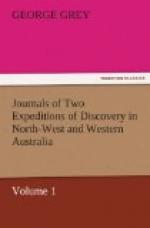Soon after quitting this nest we found a very convenient pass through a deep and fertile valley, which led directly up into the heart of the sandstone range; a fine stream ran through it in which were several large reservoirs of fresh water; the hills on each side were lofty, being at times of a rounded character, and at others broken into precipitous and fantastic cliffs; the country was thinly wooded with large timber, and the varied scenery, the facility which the country afforded for travelling, and the pleasure incident on finding ourselves clear of the marshy ground which had so long encumbered our movements, combined to make me push along as fast as possible; the only check was the heat of the sun; and it should always be borne in mind that no parallel whatever can be instituted between travels in tropical and extra-tropical Australia, for in the former the more exhausting nature of the climate unfits both men and horses for making long journeys, and indeed renders it almost impossible to travel during the heat of the day, whilst the difficult nature of the ground caused by the dense vegetation, the jungles, the ravines, and marshes, render it altogether impracticable to move at night through an unknown country.
Wild oats.
We crossed during the day several recent tracks of natives but did not fall in with the natives themselves; we also saw many kangaroos, and halted for the night on an elevated basaltic ridge, at a point close to which there was a large crop of the grain which we called wild oats. This is a remarkable vegetable production, growing to the height of from five to six feet; in the stalk, the shape, and mode of insertion of the leaves it is similar to the oat of Europe; the manner in which the seeds grow in the two plants is also the same, and the seeds are nearly of the same size, but the Australian oat is furnished with a beard like the barley. When hungry I have repeatedly eaten these oats, which in some parts grow in such abundance that several acres of them might be mown at once; and I have little doubt that this plant would with cultivation turn out to be a very great addition to our tropical grains.*
(Footnote. I am informed that the seeds of it which I introduced into the Isle of France in 1838 have greatly multiplied and that the plants are in a very flourishing state.)
March 25.
This morning we resumed our journey, crossing a succession of basaltic valleys. The vegetation was luxuriant beyond description; and it was ludicrous to see the heavy-tailed kangaroos leaping and floundering about in the long grass when they had quitted their beaten pathways and were suddenly disturbed by our approach.
CURIOUS BIRDS.
In crossing the second of these large valleys we saw two large white and black birds, more like pelicans than any other kind I am acquainted with; they had webbed feet, and the colour and form of their body resembled that of the pelican, but the head and beak were very different; after flying two or three times round our heads, well out of shot, so as to have a good peep at us, they flew away, and for the first and last time I saw this curious bird.




